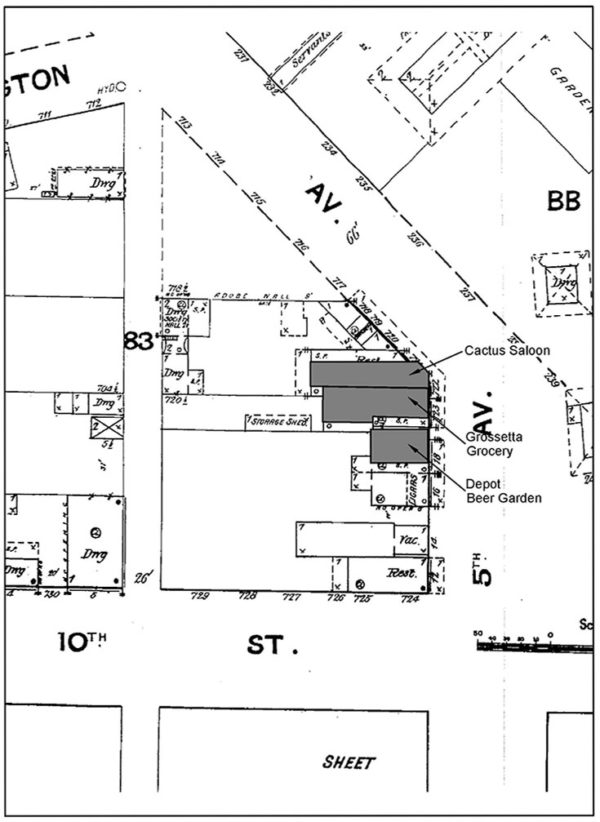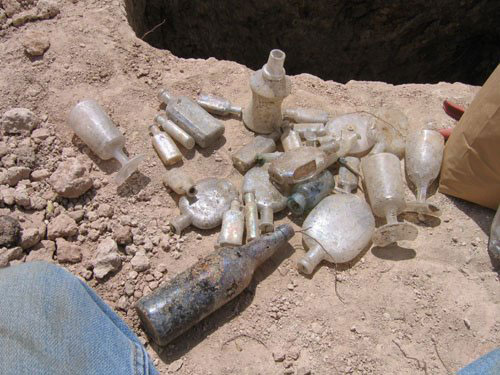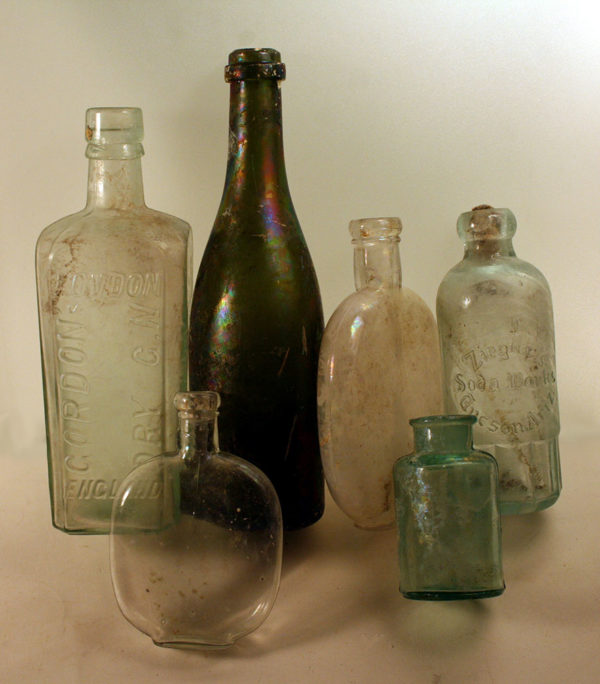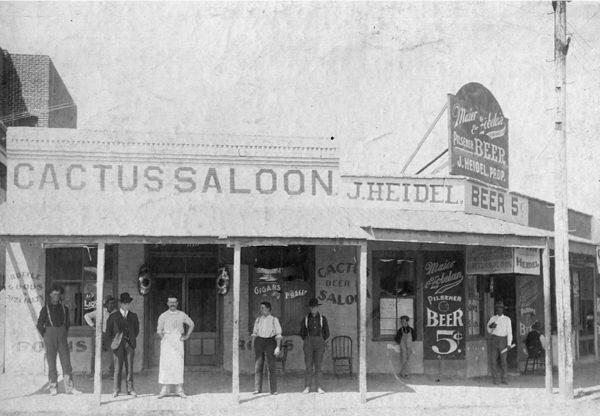
Stopping in at the Cactus Saloon
Following up on last week’s post about historic Block 83 in downtown Tucson, Homer Thiel takes us on a tour of the Cactus Saloon, which served railroad passengers and local Tucsonans from the late 1800s to the early 1900s.
Many businesses opened on the east half of Block 83 in downtown Tucson after the Southern Pacific Railroad arrived in March 1880, serving people awaiting the daily passenger trains or those getting off the train. These included barbershops, a hotel, a grocery, and a beer garden. The longest-lasting business was the Cactus Saloon, in operation at the corner of Toole Avenue and 5th Avenue from at least to 1884 to 1910.

1889 Sanborn Fire Insurance map showing the location of the Cactus Saloon, at the corner of 5th Avenue and Toole Avenue in downtown Tucson.
All of the early Tucson newspapers have been digitized and made available on the internet, some on the Library of Congress’s Chronicling America website and others on commercial websites. Searching for “Cactus Saloon” results in over 600 mentions being found. Many are repeated, short advertisements. A few longer stories are also present. These, along with historic photographs and artifacts found in an outhouse on Block 83, reveal the history of a Territorial period (1856-1912) saloon.
The Cactus Saloon began operation as early as 1883. George Sicocan, an Austrian immigrant, was its original proprietor. Besides selling alcoholic beverages, one could also find “Canned fruit of all kinds for sale at the Cactus Saloon.” By 1889, Johnny Hart was the owner of the bar. He had an awning built over the front of the saloon and a water trough placed there to entice horse owners to step inside. A free lunch was also offered every day, likely a draw for many single men in Tucson.
The saloon was one story tall. It had a pair of doors leading into its interior, with large plate glass windows on each side of the doors.
An interior photograph indicates the bar was on the south side of the saloon, with a jaguar pelt draped over a mirror and rows of liquor bottles. A footrest rail was on the patron side of the bar, with at least one spittoon present. An 1898 City of Tucson ordinance banned spitting on floors of public buildings, so local businesses placed spittoons to avoid fines.
In December 1889 a newspaper advertisement stated: “At the Cactus saloon, near the Depot, you can always get sandwiches of all kinds, fresh made ham, cheese, sardines and sausages.” Hart also sold wine, liquors, Key West cigars, and keg beer. J. W. Mitchell was the proprietor in 1891 and advertised “A Cold Bite or a Hot Cup of Coffee. A Cooling Drink of Beer or a Bracing Glass of Something Stronger.“
An incident in the saloon in 1898 made the news: “Ed Jones, colored, was shot in the Cactus saloon Saturday night and died in a few minutes. F. Miller, barkeeper in the saloon, who fired the fatal shot, surrendered to the authorities at once. An inquest was held this morning and the testimony of several witnesses was taken. All agreed that Jones had given Miller great provocation, finally threatening to smash him with a cuspidor [spittoon], also making a movement toward his hip pocket as if to draw a gun. Till this occurred, the witnesses agreed that Miller had been most patient and forbearing, in spite of repeated threats. The coroner’s jury rendered a verdict to the effect that the deceased came to his death by a gunshot wound at the hands of T. Miller, who was justifiable in his action. Jones had been employed in town as a cook for about three weeks, coming here from Kansas City.”
In 1901 the saloon was run by Johnny F. Hansen. A cook named Frank Shordner choked to death at the saloon in October 1901. In 1902, James Reilly cut William Ledger with a knife at the establishment. “There was a lively mix-up in the Cactus saloon along in the afternoon. Two men came out of this scrap with broken heads.”
The Cactus Saloon was operated by John Heidel in the early 1900s, at which time the address was listed as 31 North 5th Avenue, with the telephone number Black 351. He offered “Lunches at All Hours Wines, Liquors and Cigars” as well as furnished rooms. An armed robber was captured in the saloon in July 1906. In August 1907, a young miner named William Beck claimed that he was robbed of fifty dollars and his luggage by other miners at the saloon.
George F. Grisbell took over the saloon in September 1909. In August 1910, the saloon license was in John D. Tredeman’s name and he was transferring it to L. Gherna. Gherna was fined $75 for allowing gambling with money and dice in his saloon on 17 October 1910.
The 2006 excavations on the east half of Block 83 located Feature 207, an outhouse pit from the Cactus Saloon that was 1.88 m long, 1.10 m wide, and 2.66 m deep.

Bottles and glassware recovered from Feature 207 (photo by Homer Thiel).
Many artifacts were recovered from its fill. These included pieces of window glass with hand-painted lettering, fragments of an Anheuser-Busch embossed mirror, shot glasses, goblets, beer steins, shoe polish bottles, and many different types of alcoholic beverage bottles. Items with maker’s marks indicated the artifacts that were tossed into the outhouse dated between 1897 and 1905.

Fragments of window glass with advertisement lettering. One fragment says N.Y., perhaps for a beer brand from that state. The other has the letters FOO for FOOD. The Cactus Saloon offered many types of lunch foods (photo by Robert Ciaccio).

Fragments from an Anheuser-Busch mirror, which once hung behind the bar at the Cactus Saloon (photo by Robert Ciaccio).

Some of the bottles recovered from Feature 207. Back row: Gordon’s Gin, an olive green wine or champagne bottle, a pumpkinseed flask for whiskey, and a Zeigler’s soda bottle. Front row: another pumpkinseed flask and a shoe polish bottle (photo by Robert Ciaccio).
These finds and newspaper accounts indicate that the male patrons of the Cactus Saloon could purchase a variety of alcoholic beverages, served in appropriate glassware. They could also purchase cigars and tobacco that could be rolled into cigarettes. Someone waiting for the train could have their shoes shined. It is uncertain whether gambling was a common pastime in the bar, as newspaper articles suggest that activity was more common in other saloons.
The Cactus Saloon’s name was changed to the Pullman Bar sometime in 1910, and the saloon closed for good after Arizona Prohibition took effect on January 1, 1915. The building was still standing in 1949, but has since been demolished.




